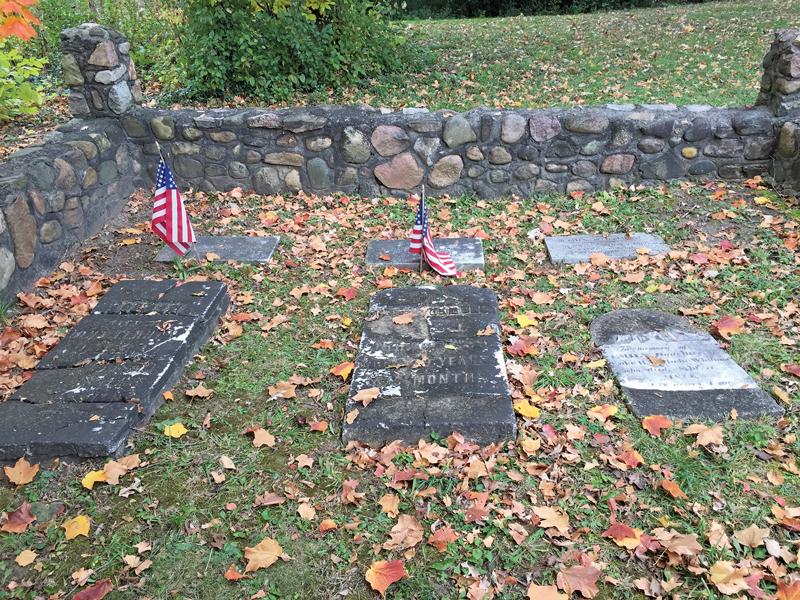Over the past year, Cobblestone Farm Association president George Taylor has marshalled an impressive array of experts to help answer that question: local historians, the Ann Arbor chapter of the Daughters of the American Revolution, experts in the use of ground-penetrating radar, and a U-M lecturer and students. Jointly, they’ve cast their eyes and their expertise on the Terhune Pioneer Memorial Cemetery on Ann Arbor’s southeast side.
“With new and sophisticated technology, we hope to answer at least some of the questions previous generations couldn’t answer,” says Blair Zaid, a lecturer in anthropology and archeology.
Tucked away in a residential subdivision on Terhune St, the cemetery sits on a mound accessed by steep wooden stairs. Three broken gravestones are all that remain of what historians believe is the first burial site in Ann Arbor.
Settled in the 1830s, when it was still governed by Pittsfield Township, the area had a “tremendous impact on the history of Ann Arbor,” Taylor says. But “until we connected with U-M, we were wading through legends and rumors trying to find the truth about who was buried on this site.”
According to one legend, the nearby DTE substation was built atop the cemetery after it fell into disrepair. Another says that a farmer threw the other tombstones in a nearby creek and plowed the consecrated land. One local resident years ago said that he saw old gravestones displayed at the nearby Ticknor farm on Stone School Road.
Historians believe as many as 200 pioneers could have been buried in Terhune. However, descendants of some exhumed and moved their ancestors’ bodies to other cemeteries when the old cemetery’s upkeep declined.
On a bone-chilling day in November, Zaid, the students, and a graduate assistant laid out a grid in string then meticulously surveyed the top of the mound and surrounding woodland with a ground-penetrating radar device borrowed from Central Michigan University. Meanwhile, Taylor, DAR members, and curious neighbors watched intently.
“Because of the nature of the site, we needed to use a nondestructive technology rather than an archaeological dig to explore the land,” Zaid explained.
Beforehand, Taylor and local historian Ed Wall (see “Pittsfield’s Historian,” p. 31) had thoroughly researched the cemetery’s history. The first person buried there, in 1825, was eighteen-year-old Emily Whitmore. Wall says that her father, Luke Whitmore, “selected a burial site on a small knoll on his property, the knoll being just a little closer to heaven.”
Eventually, Luke Whitmore gave twenty-four neighbors warranty deeds to the cemetery. Since no burial records were kept, “we don’t know how many or who are buried there,” Wall says. But “a remarkable mosaic of people were from this area and might have been buried here: three who served in the Michigan House of Representatives, one senator, a delegate for the governor, two were involved in forming the Republican party in Jackson, one played a major role in Lincoln’s election, four ministers (one of whom helped open China to Christian missionaries), two sheriffs, several Civil War veterans, and three Revolutionary War veterans.”
Those Revolutionary War veterans inspired the Ypsilanti and Ann Arbor DAR chapters to preserve the cemetery. When a developer tried to declare the cemetery abandoned so he could build on it, the DAR purchased the land. In 1990, the group turned ownership over to the city.
Wall has written a history of Pittsfield Township’s Revolutionary War soldiers, among them John Terhune, who was buried alongside his wife Sarah on the Whitmore land. “This is the best kind of story–full of mystery, history, and even romance,” observes DAR member Martha Valen.
Valen says the couple met when John was stationed at George Washington’s headquarters during the war and Sarah–“a very brave fifteen-year-old girl”–walked nine miles through the darkness to warn Washington that Hessian mercenaries and English troops were approaching,” Valen says. “When the war ended, they married and in time moved to Michigan.”
“The DAR is based on preserving the legacy and the stories of our patriots who fought and served during the War of Independence,” says Terri Kleinschmidt, president of Ann Arbor’s Sarah Caswell Angell Chapter. “Each grave site is extraordinarily important to us.”
Zaid won’t discuss the findings until the final analysis is complete, but she does say that first-glance results showed “several exciting anomalies” in the ground.
Taylor speculates: “One Whitmore child died in Chicago, and her body was brought back home in a copper box, so she could be buried in this cemetery. The anomaly might be that box.”

The 1856 and 1864 plat maps show a graveyard at the northwest corner of Burton and Packard.
Thanks for the history of the first burial site for settlers from Europe. Of course there were also indigenous burial sites pre-European settlement as well. That is also part of the region’s history.